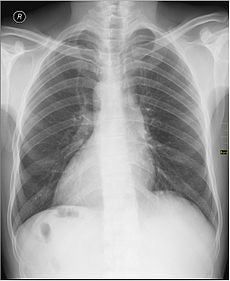- Dextrocardia
-
Dextrocardia Classification and external resources 
Chest X ray of a person with dextrocardia showing the cardiac apex facing the rightICD-10 Q24.0 ICD-9 746.87 DiseasesDB 3617 MedlinePlus 007326 MeSH C14.240.400.280 Dextrocardia is a congenital defect in which the heart is situated on the right side of the body. There are two main types of dextrocardia: dextrocardia of embryonic arrest (also known as isolated dextrocardia) and dextrocardia situs inversus. Dextrocardia situs inversus is further divided.
Contents
Dextrocardia of embryonic arrest
In this form of dextrocardia, the heart is simply placed farther right in the thorax than is normal. It is commonly associated with severe defects of the heart and related abnormalities including pulmonary hypoplasia.[1]
Dextrocardia situs inversus
Dextrocardia situs inversus refers to the heart being a mirror image situated on the right side. For all visceral organs to be mirrored, the correct term is dextrocardia situs inversus totalis.
Dextrocardia is believed to occur in approximately 1 in 12,000 people,[2]
Kartagener’s syndrome occurs in approximately 1 in 25 of totalis. This disorder affects the sinus and bronchial cilia causing constant sinus and bronchial symptoms that medication cannot rectify. With Kartagener’s both are usually present all year rather than being seasonal.
Although statistically people with dextrocardia situs inversus do not have any medical problems from the disorder, some are prone to a number of bowel, esophagus, bronchial and cardiac problems. Some of these conditions can be life threatening if left unchecked.
Diagnosis
Medical diagnosis of the two forms of congenital dextrocardia can be made by ECG[1] or imaging.
Technical dextrocardia
Technical dextrocardia refers to an ECG reading that has no basis in the patient's anatomy. This apparent presentation of dextrocardia is caused usually by the technician inadvertently swapping the limb leads on a 12 lead ECG. Usually this would show as an extreme axis deviation.
Management
ECG leads must be placed in reversed positions on a person with dextrocardia. In addition, when defibrillating someone with dextrocardia, the pads should be placed in reverse positions.[citation needed] That is, instead of upper right and lower left, pads should be placed upper left and lower right.
References
- ^ a b M. E. Abbott and J. C. Meakins (1915). "On the differentiation of two forms of congenital dextrocardia". Bulletin of the International Association of Medical Museums (5): 134–138. http://books.google.com/?id=KKK4AAAAIAAJ&pg=PA134.
- ^ Bohun CM, Potts JE, Casey BM, Sandor GG (July 2007). "A population-based study of cardiac malformations and outcomes associated with dextrocardia". Am. J. Cardiol. 100 (2): 305–9. doi:10.1016/j.amjcard.2007.02.095. PMID 17631088. http://linkinghub.elsevier.com/retrieve/pii/S0002914907007205.
External links
- MedEd at Loyola GrossAnatomy/thorax0/Heart_Development/Dextrocardia.html
- Overview at rch.org.au
- Dextrocardia at NIH's Office of Rare Diseases
- Dextrocardia with situs inversus at NIH's Office of Rare Diseases
Side Left Both Right General Ambidexterity In cognitive abilities Geschwind–Galaburda hypothesis In brain Brain asymmetry · Dual brain theory · Bicameralism In eyes Ocular dominance In hands Left-handedness Cross-dominance Right-handedness Handedness in boxing Southpaw stance Orthodox stance Handedness in people Musicians · US presidents Handedness related to Sex · Maths Handedness measurement Edinburgh Handedness Inventory Handedness genetics LRRTM1 In heart Levocardia Dextrocardia In major viscera Situs solitus Situs ambiguus Situs inversus In feet Footedness Congenital heart defects (Q20–Q24, 745–746) Cardiac shunt/
heart septal defectAortopulmonary septal defectR→L: Double outlet right ventricle (Taussig–Bing syndrome) · Transposition of the great vessels (dextro, levo) · Persistent truncus arteriosusL→R: Sinus venosus atrial septal defect · Lutembacher's syndromeL→R and R→L: Eisenmenger's syndromeR→L, with other conditions: Tetralogy of FallotL→R: Ostium primumValvular heart disease/
heart chambersRightpulmonary valves (stenosis, insufficiency) · tricuspid valves (stenosis, atresia, Ebstein's anomaly) · Hypoplastic right heart syndrome (Uhl anomaly)LeftOther Dextrocardia · Levocardia · Cor triatriatum · Crisscross heart · Brugada syndrome · Coronary artery anomaly · Anomalous aortic origin of a coronary artery · Ventricular inversionCategories:- Congenital disorders of circulatory system
Wikimedia Foundation. 2010.
